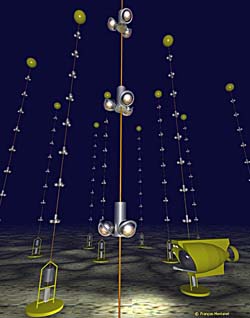Michal Levinstein, Israel Astronomical Society

Direct link to this page: https://www.hayadan.org.il/neutrinos0505.html
Bennett Link of the University of Montana and Fiorella Burgio of the National Institute of Nuclear Physics in Italy speculate that pulsars may produce more than their familiar radio beams. The scientists claim that these stellar remnants could be among the most powerful sources of muon neutrinos in the sky.
(A neutrino is a particle without an electrical charge produced in nuclear processes, which easily passes through matter but hardly reacts with it - M.L.)
A pulsar is a rotating neutron star that produces strong magnetic fields and produces energy in a way similar to a beam of light, which is usually detected in the length of radio waves. "There are neutron stars that produce magnetic fields that are a billion times stronger than those produced on Earth using supermagnets," says Link.
Neutrino particles are particles that exist in the blink of an eye and are created in astrophysical situations - from normal nuclear fusion in stars, to a supernova explosion. Since these particles are not actually composed of ordinary matter, they can provide astronomers with information from vast distances and from places that no probe can reach - but that is precisely why they are so difficult to locate.
A neutron star is born over the course of 100,000 years and produces energy like our Sun - but with a face 5 billion times smaller than it and usually in the form of X-rays. The electric and magnetic fields of the pulsar bring charged particles easily to a speed close to the speed of light. This is what creates the drift beam now observed from more than 1,500 neutron stars.
Link and Borgio agree that these fields accelerate protons to high enough energy levels close to the pulsar's surface that the particles scatter from the star's X-rays and produce muon-neutrinos. "Like radio waves, the neutrino beam will drift away as the star rotates. If its path crosses the Earth - the star will truly be considered a neutrino star" says Link.
Neutrino-producing pulsars can be considered among the most powerful high-energy muon-neutrino-producing sources in the sky and probably the first to be discovered. "The discovery of high-energy neutrinos from astrophysical sources will open an exciting new window for the study of high-energy astrophysical processes," says Link.
The research team estimates that there are 10 neutrino pulsars up to a distance of 15,000 light years from Earth and offers 2 detection facilities within reach:
The French "Antares" project - is currently being built in the depths of the Mediterranean Sea and will start operating in 2007.
The "Ice Cube" project - a neutrino telescope in the shape of a km-sized cube will be built inside the ice at the North Pole in Antarctica.
(The facilities are built deep below the surface, since neutrino particles have no problem passing through ordinary matter, and in order to isolate as much as possible the cosmic background radiation - ML)
"At energies of a trillion electron volts and more, the cosmic background radiation - which could be a source of interference for the Antares project - is so weak that if even a single muon is seen - it could be statistically considered a neutrino discovery," the team notes.
Yadan Astrophysics 2 - Stars in their lives and deaths
The website of the Israeli Astronomical Society
For information on the ASTRONOMY website
https://www.hayadan.org.il/BuildaGate4/general2/data_card.php?Cat=~~~167623532~~~97&SiteName=hayadan
